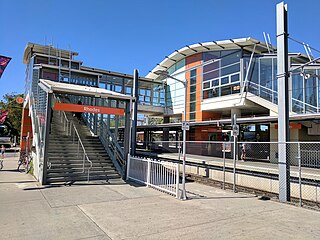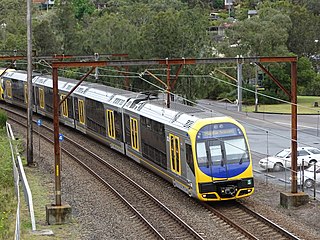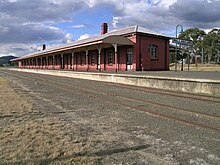
The Australian state of New South Wales has an extensive network of railways, which were integral to the growth and development of the state. The vast majority of railway lines were government built and operated, but there were also several private railways, some of which operate to this day.
Australians generally assumed in the 1850s that railways would be built by the private sector. Private companies built railways in the then colonies of Victoria, opened in 1854, and New South Wales, where the company was taken over by the government before completion in 1855, due to bankruptcy. South Australia's railways were government owned from the beginning, including a horse-drawn line opened in 1854 and a steam-powered line opened in 1856. In Victoria, the private railways were soon found not to be financially viable, and existing rail networks and their expansion were taken over by the colony. Government ownership also enabled railways to be built to promote development, even if not apparently viable in strictly financial terms. The railway systems spread from the colonial capitals, except for a few lines that hauled commodities to a rural port.
The State Rail Authority, a former statutory authority of the Government of New South Wales, operated and maintained railways in the Australian state of New South Wales from July 1980 until December 2003.

Rhodes railway station is a heritage-listed railway station located on the Main Northern line, serving the Sydney suburbs of Rhodes and Liberty Grove both in City of Canada Bay, Sydney, New South Wales, Australia. It is served by Sydney Trains' T9 Northern Line services.

The Central Coast & Newcastle Line (CCN) is an intercity rail service operated by NSW TrainLink that services the Hawkesbury River, Central Coast and Newcastle regions. It connects the two largest cities in New South Wales, running from Central in Sydney along the Main North railway line to Broadmeadow, and to Newcastle Interchange in Newcastle on the Newcastle railway line.

Hawkesbury River railway station is a heritage-listed railway station located on the Main Northern and Central Coast–Newcastle lines in Brooklyn in the Hornsby Shire local government area of Sydney, New South Wales, Australia. The station serves the town of Brooklyn and is located on the southern bank of the Hawkesbury River. It was designed and build by the Department of Railways New South Wales. It is also known as Hawkesbury River Railway Station group and Brooklyn Station. The property was added to the New South Wales State Heritage Register on 2 April 1999.

Woy Woy railway station is located on the Main Northern line in New South Wales, Australia. It serves the southern Central Coast town of Woy Woy opening on 1 February 1889.

Gosford railway station is located on the Main Northern line in New South Wales, Australia. It serves the Central Coast city of Gosford, opening on 15 August 1887.

The North Coast railway line is the primary rail route in the Mid North Coast and Northern Rivers regions of New South Wales, Australia, and forms a major part of the Sydney–Brisbane rail corridor.

The Sydney Freight Network is a network of dedicated railway lines for freight in Sydney, Australia, linking the state's rural and interstate rail network with the city's main yard at Enfield and Port Botany. Its primary components are the Southern Sydney Freight Line (SSFL) and a line from Sefton to Enfield and Port Botany. The Network has been managed by the Australian Rail Track Corporation (ARTC) since 2012. Prior to the completion of the SSFL, it was managed by RailCorp as the Metropolitan Freight Network.

Sydney, the largest city in Australia, has an extensive network of passenger and goods railways. The passenger system includes an extensive suburban railway network, operated by Sydney Trains, a metro system and a light rail network. A dedicated goods network also exists.
The Main Western Railway is a major railway in New South Wales, Australia. It runs through the Blue Mountains, and Central West regions. It is 825 kilometres (513 mi) long, of which 484 kilometres (301 mi) is currently operational.
The Mungindi railway line is a railway line in northern New South Wales, Australia. It branches from the Main North line at Werris Creek station and heads north-west through the towns of Gunnedah and Narrabri before reaching Moree which for many years was the railhead before the extension to Mungindi was constructed. The line is currently truncated to Weemelah between Moree and Mungindi. Passenger trains still operate to Moree, and goods trains operate to Camurra. As of 1 September 2009, services have been suspended between Camurra and Weemelah. The line between Werris Creek and Moree is also known as the North-West line.

The Sydney–Brisbane railway corridor consists of the 987-kilometre (613-mile) long 1435 mm standard-gauge main line between the Australian state capitals of Brisbane (Queensland) and Sydney, and the lines immediately connected to it.

The Southern railway line serves the Darling Downs region of Queensland, Australia. The 197-kilometre (122 mi) long line branches from the Western line at Toowoomba, 161 kilometres (100 mi) west of Brisbane, and proceeds south through Warwick and Stanthorpe to the New South Wales/Queensland state border at Wallangarra.

The Northern Sydney Freight Corridor (NSFC) was a project to improve access between Sydney and Newcastle for freight trains. Frequent passenger services operate on the Main Northern line between Strathfield and Broadmeadow. These passenger services take priority, meaning freight trains can be delayed and are subject to a curfew during peak hours. The Northern Sydney Freight Corridor aimed to reduce delays and increase capacity by providing additional train paths. The delivery of the NSFC projects was managed by Transport for NSW, with the exception of the Hexham freight loop which was delivered in June 2012 by the Australian Rail Track Corporation. The final stage was completed in June 2016.

Armidale railway station is a heritage-listed railway station at 240 Brown Street, Armidale, New South Wales, Australia. It was built from 1882 to 1883 by Edmund Lonsdale and Henry Sheldon Hoddard, and was opened on 3 February 1883 when the line was extended from Uralla. It was the terminus of the line until it was extended to Glen Innes on 19 August 1884. It was added to the New South Wales State Heritage Register on 2 April 1999.

The Woy Woy railway tunnel is a heritage-listed railway tunnel located between Wondabyne and Woy Woy stations on the Main Northern railway line in New South Wales, Australia. The dual-track 1.69-kilometre tunnel was opened on 16 January 1888. It was added to the New South Wales State Heritage Register on 28 June 2013.
The Northern Mail was an Australian passenger train that ran from Sydney to Armidale, Glen Innes, Tenterfield and Moree from the 1870s until November 1988.

Wallangarra railway station is a heritage-listed railway station at Woodlawn Street, Wallangarra, Southern Downs Region, Queensland, Australia. It was built in 1877 along the state border of Queensland and New South Wales It was added to the Queensland Heritage Register on 28 March 2003.




















